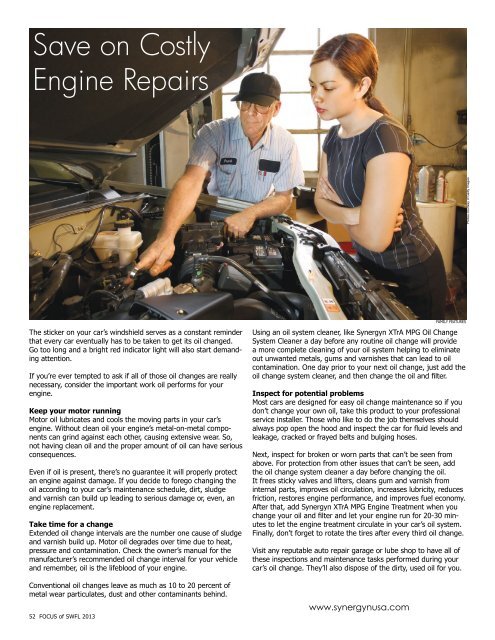FOCusof ARTIST
You also want an ePaper? Increase the reach of your titles
YUMPU automatically turns print PDFs into web optimized ePapers that Google loves.
Save on Costly<br />
Engine Repairs<br />
Photos courtesy of Getty Images<br />
The sticker on your car’s windshield serves as a constant reminder<br />
that every car eventually has to be taken to get its oil changed.<br />
Go too long and a bright red indicator light will also start demanding<br />
attention.<br />
If you’re ever tempted to ask if all of those oil changes are really<br />
necessary, consider the important work oil performs for your<br />
engine.<br />
Keep your motor running<br />
Motor oil lubricates and cools the moving parts in your car’s<br />
engine. Without clean oil your engine’s metal-on-metal components<br />
can grind against each other, causing extensive wear. So,<br />
not having clean oil and the proper amount of oil can have serious<br />
consequences.<br />
Even if oil is present, there’s no guarantee it will properly protect<br />
an engine against damage. If you decide to forego changing the<br />
oil according to your car’s maintenance schedule, dirt, sludge<br />
and varnish can build up leading to serious damage or, even, an<br />
engine replacement.<br />
Take time for a change<br />
Extended oil change intervals are the number one cause of sludge<br />
and varnish build up. Motor oil degrades over time due to heat,<br />
pressure and contamination. Check the owner’s manual for the<br />
manufacturer’s recommended oil change interval for your vehicle<br />
and remember, oil is the lifeblood of your engine.<br />
Conventional oil changes leave as much as 10 to 20 percent of<br />
metal wear particulates, dust and other contaminants behind.<br />
52 FOCUS of SWFL 2013<br />
Using an oil system cleaner, like Synergyn XTrA MPG Oil Change<br />
System Cleaner a day before any routine oil change will provide<br />
a more complete cleaning of your oil system helping to eliminate<br />
out unwanted metals, gums and varnishes that can lead to oil<br />
contamination. One day prior to your next oil change, just add the<br />
oil change system cleaner, and then change the oil and filter.<br />
Inspect for potential problems<br />
Most cars are designed for easy oil change maintenance so if you<br />
don’t change your own oil, take this product to your professional<br />
service installer. Those who like to do the job themselves should<br />
always pop open the hood and inspect the car for fluid levels and<br />
leakage, cracked or frayed belts and bulging hoses.<br />
Next, inspect for broken or worn parts that can’t be seen from<br />
above. For protection from other issues that can’t be seen, add<br />
the oil change system cleaner a day before changing the oil.<br />
It frees sticky valves and lifters, cleans gum and varnish from<br />
internal parts, improves oil circulation, increases lubricity, reduces<br />
friction, restores engine performance, and improves fuel economy.<br />
After that, add Synergyn XTrA MPG Engine Treatment when you<br />
change your oil and filter and let your engine run for 20-30 minutes<br />
to let the engine treatment circulate in your car’s oil system.<br />
Finally, don’t forget to rotate the tires after every third oil change.<br />
Visit any reputable auto repair garage or lube shop to have all of<br />
these inspections and maintenance tasks performed during your<br />
car’s oil change. They’ll also dispose of the dirty, used oil for you.<br />
www.synergynusa.com<br />
Family Features

















